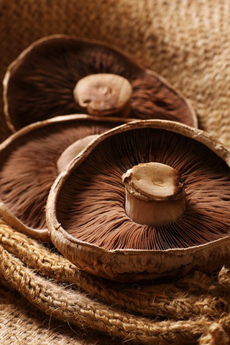This is Page 5 of a six-page article. Click on the black links below to visit other pages.
| My Name |
Get To Know Me |
Lobster Mushroom
So called because it’s the color of a steamed lobster, although the lobster mushroom is actually a white mushroom that is coated by a red fungus. It is perhaps the meatiest mushroom, even meatier than most portobello mushrooms. The flavor is sweet and delicate, and delicious. Their season is August to November. |
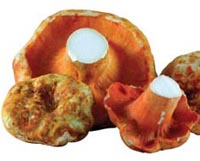
Photo courtesy of MarxFoods.com. |
Maitake Mushroom
See Hen Of The Woods Mushroom. Maitake has a robust, earthy flavor and fragrance and can be prepared in many ways including stir-fry, sautéed, and baked. Tempura-battered, deep-fried maitake mushrooms are very popular in Japan. |
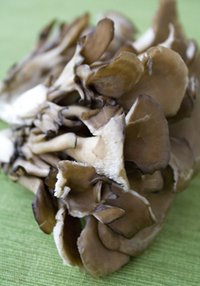
Photo of organic Golden Gourmet Mushrooms by Claire Freierman | THE NIBBLE. |
Matsutake or Pine Mushroom
Matsutake is a meaty mushroom like the porcinis and portobellos, with a savory, pungent flavor and rich aroma. The larger ones have steak-like caps, thick stems and intense flavor. |
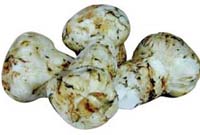
Photo courtesy of MarxFoods.com. |
Morel or Sponge Mushroom
The shape of morels sets them apart from most other mushrooms (they’re also called “gnomes’ caps”). They have a hollow interior which must be rinsed before cooking as they harbor insects, and can be stuffed. Their intense, nutty and earthy flavor tastes wonderful when sautéed simply in olive oil or butter; and they are heaven with beef. Morels are a great enhancement to gravies and stews in place of (or in addition to) meat. Morels are a spring mushroom, typically available fresh from late March to the end of May, although the season in the Pacific Northwest can last until July. Varieties include rounds from Turkey; conica from the Pacific Northwest, Kentucky and Louisiana*; and blondes/naturals from Michigan.* Success has finally been achieved in cultivating them, so we can look forward to having them fresh year-found. Dried morels are also excellent.
|
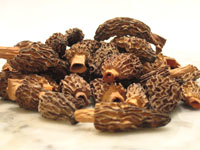
Photo courtesy of Caviar Russe.
*And elsewhere. |
Nameko Mushroom
See Forest Nameko Mushroom. |
|
Oyster Mushroom or Pleurotte
Oyster mushrooms have a velvety texture that is reminiscent of its namesake. All varieties are stunning—see the Baby Blue Oyster mushrooms at right. You can also find them in pink, as well as the more standard off-white, yellow, and grey-brown colors. They have prominent, ridged gills on the underside. While the flavor is delicate, they look beautiful. Toss them into a salad; sauté lightly with chicken, pork or seafood; or use them as a beautiful garnish. (Be sure to include them in your mixed wild mushroom dishes.) They are available year round.
|
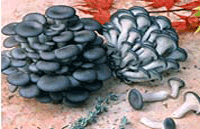
Photo courtesy of Gourmet Mushrooms, Inc. |
Pfifferling Mushroom
See Chanterelle Mushroom. |
|
Pied de Mouton
See Hedgehog Mushroom. |
|
Pine Mushroom
See Matsutake Mushroom. |
|
Pleurotte or Pleurotus Mushroom
See Oyster Mushroom. |
|
Porcini Mushroom
See Cep Mushroom. |
|
Portabella or Portobello Mushroom
Cremini mushrooms grow up into more complex-flavored portabellas, meaty in both taste and appearance—they can be 3 to 10 inches in diameter. Like meat, they even release juices when cooked. Vegetarians enjoy them grilled in lieu of beef, and they make wonderful grilled vegetable sandwiches. They are brown, with a slightly firmer texture than white mushrooms, and can be served whole or sliced, stuffed or as “burgers.” For a simple starter, serve sliced grilled portobello drizzled with a balsamic reduction. They are available fresh from December to March and cultivated year round.
|
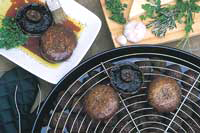
Photo courtesy of AllSeasonsMushrooms.com.
TIP: Cook Portabellas gills down for the first 10 minutes to allow moisture to escape. |
Lifestyle Direct, Inc. All rights reserved. Images are the copyright of their respective owners.


